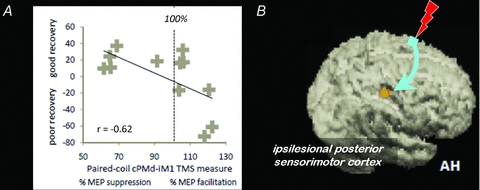Figure 2.

A, scatterplot showing the correlation, with regression line, between the combined clinical score and the interhemispheric cPMd-iM1 influence measured with paired-coil TMS (conditioned MEP/unconditioned MEP as a %) in each patient. For the combined clinical score (along they-axis) a higher value indicates better residual motor function. This measure correlated with the value of the interhemispheric cPMd-iM1 influence shown along thex-axis: a better motor recovery was associated with a physiological ‘inhibitory’ effect whereas poorer recovery was associated with less interhemispheric inhibition or even facilitation (i.e. paired-coil effects of >100%, as for the rightmost cases).B, statistical parametric map (SPM) for the interaction term TMShigh (GRIP − REST) > TMSlow (GRIP − REST) during concurrent TMS-fMRI overlaid on the rendered mean structural scan from all patients. In other words, the only brain region that contralesional PMd had an effect on during hand grip was ipsilesional sensorimotor cortex. The facilitatory influence of contralesional PMd on ipsilesional sensorimotor cortex during affected hand grip was found in all chronic subcortical stroke patients, but was greater in patients with more impairment. AH: affected hemisphere. (From Bestman et al. 2010.)
